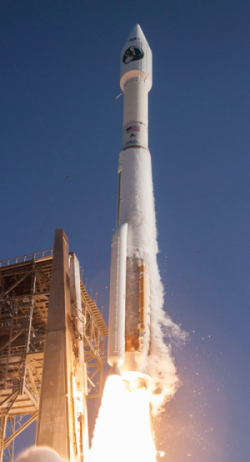ULA lets the press see part of SLS
Link here. The upper stage of SLS is undergoing its final testing in Michoud prior to shipment to Florida, and ULA had a press event to show it off.
“This is the first piece of integrated flight hardware for the SLS system to be shipped down to the Cape in preparation for our very first launch,” said Jerry Cook, Deputy SLS Program Manager for NASA. Cook noted that the ICPS test article is currently undergoing stress and load tests at Marshall.
The completion of the ICPS is yet another landmark in SLS’ development, though some contend it’s still a drawing-board vehicle. John Shannon, Boeing’s Vice President and General Manager of the SLS Program, disagrees. “The SLS has, in various forms, been called a paper rocket […] and, if I think you look to your right, you’ll see that absolutely is not true,” stated Shannon. “If you had the opportunity to go to the Michoud Assembly Facility in New Orleans, where we’re putting the bigger core stage together, you would also see that it is not true because we are putting hardware together as we speak.”
This upper stage engine is a brand new design and has never flown before, and the rocket it is part of has yet to be assembled. Yet NASA is considering flying humans on it during its first test flight, even as it harasses SpaceX and Boeing about using the Falcon 9 and Atlas 5 rockets, both proven repeatedly in operational flights, for their manned ISS missions.
The article also gives an update on the situation at Michoud since it was hit by a tornado on February 8. It appears that the facility is operating again, but not fully.
Link here. The upper stage of SLS is undergoing its final testing in Michoud prior to shipment to Florida, and ULA had a press event to show it off.
“This is the first piece of integrated flight hardware for the SLS system to be shipped down to the Cape in preparation for our very first launch,” said Jerry Cook, Deputy SLS Program Manager for NASA. Cook noted that the ICPS test article is currently undergoing stress and load tests at Marshall.
The completion of the ICPS is yet another landmark in SLS’ development, though some contend it’s still a drawing-board vehicle. John Shannon, Boeing’s Vice President and General Manager of the SLS Program, disagrees. “The SLS has, in various forms, been called a paper rocket […] and, if I think you look to your right, you’ll see that absolutely is not true,” stated Shannon. “If you had the opportunity to go to the Michoud Assembly Facility in New Orleans, where we’re putting the bigger core stage together, you would also see that it is not true because we are putting hardware together as we speak.”
This upper stage engine is a brand new design and has never flown before, and the rocket it is part of has yet to be assembled. Yet NASA is considering flying humans on it during its first test flight, even as it harasses SpaceX and Boeing about using the Falcon 9 and Atlas 5 rockets, both proven repeatedly in operational flights, for their manned ISS missions.
The article also gives an update on the situation at Michoud since it was hit by a tornado on February 8. It appears that the facility is operating again, but not fully.

